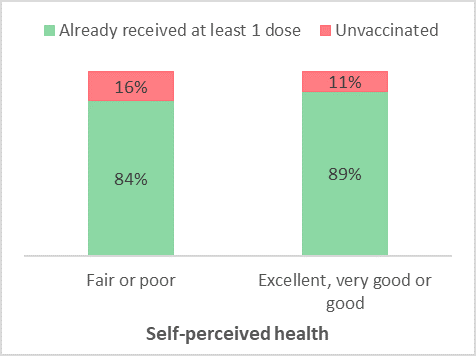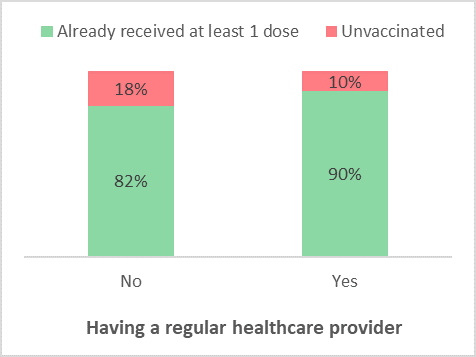COVID-19 vaccine uptake and intent: Canadian Community Health Survey (CCHS) insight
On this page
- Purpose
- Highlights
- Survey collection methodology
- Disparities in vaccine uptake
- Disparities in vaccination intent
- Implications for public health
- Contact us
Purpose
Using the data from the Canadian Community Health Survey (CCHS), the purpose of this study is to:
- assess inequalities in COVID-19 vaccine uptake and intent at the national level by identifying the sociodemographic factors associated with non-vaccination and low vaccination intent
- supplement information already collected by the Canadian COVID-19 vaccination coverage surveillance system
- inform decisions regarding COVID-19 vaccine promotion, education and outreach
Highlights
Between the survey collection period of June and August 2021:
- a majority of Canadian adults reported being vaccinated (89%) or intending to get vaccinated (6%) against COVID-19
- only 5% of adults did not intend to get vaccinated
- vaccine uptake was lower among those living with children under 12 years old, compared to others
- a smaller proportion of adults with poor self-perceived health or without a regular healthcare provider reported being vaccinated
- intent to get vaccinated was more frequent among those belonging to groups designated as a visible minority
- vaccine uptake and intent were lower among adults with less than university-level education
Survey collection methodology
The CCHS is an ongoing annual cross-sectional survey conducted by Statistics Canada that collects health-related information for the Canadian population at the sub-provincial level of geography using the computer-assisted telephone interviewing (CATI) system. The primary use of the CCHS data is for health surveillance and population health research. Questions on COVID-19 vaccination were added to the CCHS in 2020. Please refer to Statistics Canada for more information on the CCHS and the methodology of the survey, including the questionnaire.
The CCHS covers respondents aged 12 or older except:
- full-time members of the Canadian Forces
- people living in institutions
- children 12 to 17 years of age that are living in foster care
- people living on-reserve and other Aboriginal settlements in the provinces
- persons living in the Quebec health regions of Région du Nunavik and Région des Terres-Cries-de-la-Baie-James
Data selected for this analysis
The present study on COVID-19 vaccination uptake and intent used data collected from June 1, 2021, to September 5, 2021. It focused on individuals aged 18 or older since they were the group eligible for COVID-19 vaccination in all 10 provinces.
Exclusions are the following.
- Adolescents aged 12 to 17 could only book appointments for COVID-19 vaccines at the end of May 2021, which would not have given them enough time to get vaccinated before the start of this data collection period.
- The number of respondents from the territories was too small to allow a good representation of the entire population.
Data for the following collection periods September to mid-November 2021 and mid-November 2021 to end of January 2022 will be available in the future.
Overall, 10,093 people participated in CCHS between June and August 2021. The response rate was 22.8%. The response rate varied across the 10 provinces. Quebec (29.5%) had the highest response rate and Alberta had the lowest (17.0%). The sample size did not allow for analyses at the provincial level.
Disparities in vaccine uptake
Age groups
The proportion of unvaccinated adults was higher in 18 to 49 (between 13% and 17%) years old compared to those more than 60 years of age (between 4% and 7%).

Figure 1: Text description
| Age group (years) | % already received at least 1 dose | % unvaccinated |
|---|---|---|
| 18 to 29 | 83% | 17% |
| 30 to 39 | 85% | 15% |
| 40 to 49 | 87% | 13% |
| 50 to 59 | 91% | 9% |
| 60 to 69 | 93% | 7% |
| 70+ | 96% | 4% |
Presence of children under 12 years old in the household
The proportion of unvaccinated was higher among adults living with 1 or more children under 12 (15%) compared to those living without children (10%).

Figure 2: Text description
| Children under 12 in the household | % already received at least 1 dose | % unvaccinated |
|---|---|---|
| 1 or more | 85% | 15% |
| None | 90% | 10% |
Level of education
The proportion of unvaccinated adults was lower among those with a university degree (7%) compared to adults with lower levels of education (between 13% and 16%).

Figure 3: Text description
| Level of education | % already received at least 1 dose | % unvaccinated |
|---|---|---|
| Less than secondary | 84% | 16% |
| Secondary | 87% | 13% |
| Postsecondary diploma | 86% | 14% |
| University | 93% | 7% |
Health related variables: Self-perceived health, regular healthcare provider status
The proportion of unvaccinated adults was higher among those who did not have a regular healthcare provider (18%) as compared to the ones who did (10%).
The proportion of unvaccinated adults was higher in those who perceived they had fair or poor health (16%) compared to those who perceived having excellent, very good or good health (11%).


Figure 4: Text description
| Sociodemographic factor | % already received at least 1 dose | % unvaccinated |
|---|---|---|
| Self-perceived health | ||
| Fair or poor | 84% | 16% |
| Excellent, very good or good | 89% | 11% |
| Having a regular healthcare provider | ||
| No | 82% | 18% |
| Yes | 90% | 10% |
Disparities in vaccination intent
Age groups
There was no difference in vaccination intent across all age groups. The proportion of adults who were unlikely to get vaccinated was 6% for those less than 60 years of age and between 3% and 4% for the older age groups.

E: Interpret estimate with caution because of the small number of individuals in this group.
Figure 5: Text description
| Age group (years) | % likely to get vaccinated or already received at least 1 dose | % unlikely to get vaccinated |
|---|---|---|
| 18 to 29 | 94% | 6%Footnote E |
| 30 to 39 | 94% | 6%Footnote E |
| 40 to 49 | 94% | 6%Footnote E |
| 50 to 59 | 94% | 6% |
| 60 to 69 | 96% | 4% |
| 70+ | 97% | 3% |
|
||
Level of education
The proportion of adults who did not intend to get vaccinated was higher in those without a university degree (between 6% and 8%) compared to those with a university degree (3%).

E: Interpret estimate with caution because of the small number of individuals in this group.
Figure 6: Text description
| Level of education | % likely to get vaccinated or already received at least 1 dose | % unlikely to get vaccinate |
|---|---|---|
| Less than secondary | 92% | 8%Footnote E |
| Secondary | 94% | 6% |
| Postsecondary diploma | 94% | 6% |
| University | 97% | 3%Footnote E |
|
||
Self-perceived health
The proportion of individuals who did not intend to get vaccinated was higher in adults who self-perceived having a fair or poor health (9%) compared to those who perceived having excellent, very good or good health (5%).

E: Interpret estimate with caution because of the small number of individuals in this group.
Figure 7: Text description
| Self-perceived health | % likely to get vaccinated or already received at least 1 dose | % unlikely to get vaccinated |
|---|---|---|
| Fair or poor | 91% | 9%Footnote E |
| Excellent, very good or good | 95% | 5% |
|
||
Visible minority status
Intent not to get vaccinated was more frequent in those not belonging to a visible minority (6%) compared to those who identify with a visible minority group (3%).

E: Interpret estimate with caution because of the small number of individuals in this group.
Figure 8: Text description
| Visible minority status | % likely to get vaccinated or already received at least 1 dose | % unlikely to get vaccinated |
|---|---|---|
| Not a visible minority | 94% | 6% |
| Visible minority | 97% | 3%Footnote E |
|
||
Implications for public health
These findings confirm the findings of the COVID-19 Vaccination Coverage Survey.
Persistent inequalities for specific groups
Despite all the efforts deployed over the past months to make COVID-19 vaccines available to every eligible Canadian, there remains disparities in vaccine uptake among certain subgroups. For instance, vaccination uptake and intent were lower among less educated people. This may result directly from lower literacy or reflect a lower access associated with lower socioeconomic status, or both. Vaccine promotion and education campaigns could target those specific groups to increase their vaccination rates.
Parents are less vaccinated
A smaller proportion of younger Canadians and parents of children under the age of 12 years old were vaccinated compared to older age groups and adults living without children. This may be due to additional barriers faced by parents of young children to find time and child care to get vaccinated. In addition, this tendency is still observed today according to the most recent data from the Canadian COVID-19 Vaccination Coverage Surveillance System, which reinforces the perceived need to facilitate access to vaccines for parents.
Health as a factor in favor of vaccination
Higher vaccination rates were observed among those with excellent, very good or good self-perceived health, and those with a regular healthcare provider. The former group may be more health conscious and the latter may have easier access to health-related resources. Both groups may be more likely to believe that being vaccinated is the right thing to do to stay healthy.
More people who identify as visible minorities intend to get vaccinated
Higher vaccination intent among visible minorities could be associated with the fact that healthcare workers were prioritized for vaccination and that some visible minority groups are more likely to be represented among nurse aides, long-term care workers and patient service associates.
Contact us
For more information about these findings, please contact us at coverage-couvertures@phac-aspc.gc.ca.
For more information about COVID-19 vaccines
- Vaccines for COVID-19
- COVID-19 in Canada
- Canada’s vaccine supply and donation strategy
- COVID-19 Vaccination Coverage Survey (CVCS)
- Reported side effects following COVID-19 vaccination in Canada
- The facts about COVID-19 vaccines
- Publications: Vaccines and immunization